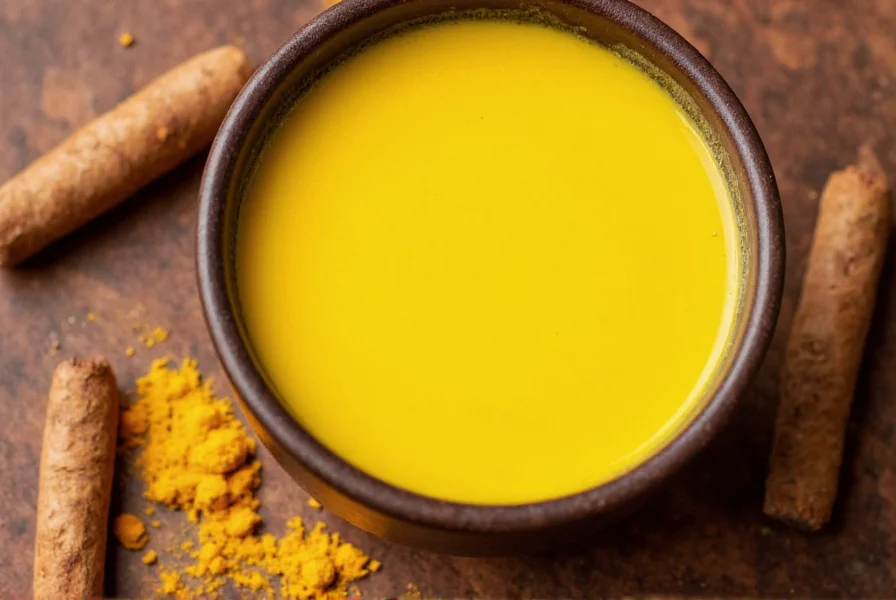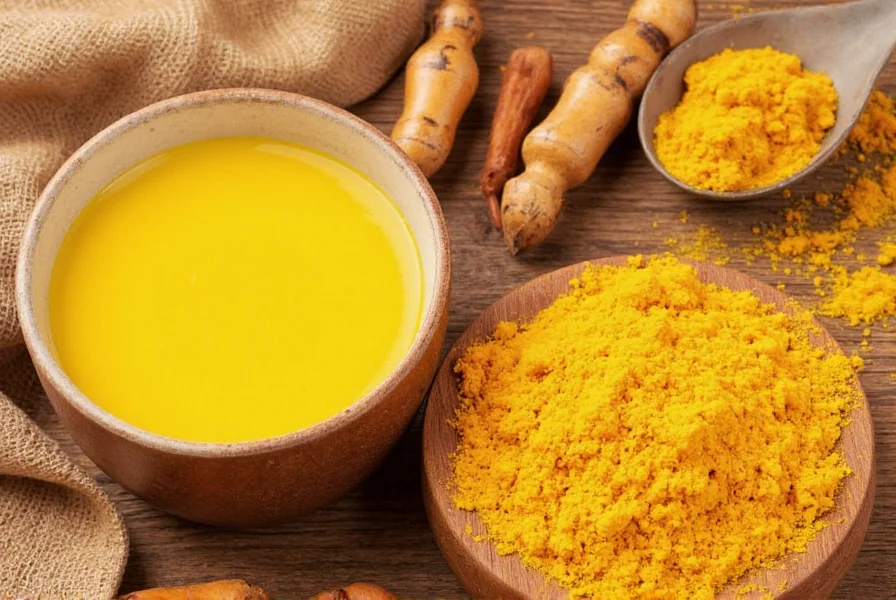Adding turmeric to milk creates a traditional beverage known as golden milk or turmeric milk, primarily consumed for its potential anti-inflammatory properties. Scientific evidence suggests that combining turmeric with milk (particularly with fat content) may enhance curcumin absorption, though most health claims require more rigorous human studies. A typical preparation uses 1/2 to 1 teaspoon of turmeric powder per cup of milk, often with black pepper to increase bioavailability.
Golden milk, the comforting blend of turmeric and milk, has journeyed from ancient Ayurvedic practice to modern wellness trends. This vibrant yellow beverage, sometimes called haldi doodh in Indian tradition, combines the bioactive compound curcumin from turmeric with milk's nutritional profile. While social media often portrays it as a miracle cure, understanding what science actually supports versus popular claims is essential for informed consumption.
The Science Behind Turmeric Milk
Curcumin, turmeric's primary active component, demonstrates poor bioavailability when consumed alone. Research published in Advances in Experimental Medicine and Biology indicates that combining curcumin with fats (like those in milk) and piperine (from black pepper) can increase absorption by up to 2,000%. This explains why traditional preparations include both milk and pepper.
Multiple studies, including a 2017 review in Foods, suggest that the fat content in dairy or plant-based milks helps solubilize curcumin, making it more accessible to the body. However, most clinical evidence comes from concentrated curcumin supplements rather than culinary preparations like turmeric milk.

Preparing Authentic Turmeric Milk
Creating effective turmeric milk requires attention to preparation details that maximize potential benefits:
| Ingredient | Amount per Cup | Scientific Rationale |
|---|---|---|
| Milk (dairy or plant-based) | 1 cup | Fat content enhances curcumin absorption |
| Turmeric powder | 1/2-1 tsp | Provides 200-400mg curcuminoids |
| Black pepper | 1/8 tsp | Piperine increases bioavailability |
| Healthy fat (optional) | 1/2 tsp coconut oil | Additional fat improves absorption |
For optimal preparation, gently heat the milk (do not boil) with turmeric and other ingredients for 5-10 minutes. This warming process, rather than boiling, preserves curcumin's integrity while enhancing solubility. Traditional Ayurvedic preparation often includes additional ingredients like ginger, cinnamon, or cardamom for complementary benefits.
Evidence-Based Benefits vs. Common Claims
While turmeric milk enjoys popularity for various health claims, scientific support varies significantly:
- Supported by moderate evidence: Temporary reduction in exercise-induced inflammation (per Journal of the International Society of Sports Nutrition)
- Preliminary evidence: Potential support for joint comfort in osteoarthritis (requires more human studies)
- Overstated claims: "Cures" for chronic diseases, significant weight loss effects, or cancer prevention
A 2020 systematic review in Nutrients concluded that while culinary turmeric shows promise, most therapeutic applications require standardized curcumin extracts at doses far exceeding what's achievable through milk preparations. The anti-inflammatory effects from a single serving of turmeric milk are likely modest compared to concentrated supplements.
Safety Considerations for Regular Consumption
Turmeric milk is generally safe for most people when consumed in culinary amounts. However, certain considerations apply:
- Excessive consumption (more than 1-2 servings daily) may cause digestive discomfort
- People with gallbladder issues should consult healthcare providers before regular use
- May interact with blood-thinning medications due to mild anticoagulant properties
- Pregnant women should limit intake to culinary amounts rather than therapeutic doses
The European Food Safety Authority considers up to 0.5 mg of curcumin per pound of body weight daily as safe. For a 150-pound person, this translates to approximately 1.5 teaspoons of turmeric powder daily—more than typically used in milk preparations.

Comparing Turmeric Delivery Methods
Different approaches to consuming turmeric offer varying benefits:
- Turmeric milk: Provides moderate curcumin absorption with nutritional benefits from milk
- Curcumin supplements: Offer standardized doses (typically 500-1,000mg) with enhanced absorption technologies
- Fresh turmeric in cooking: Delivers additional compounds beyond curcumin with culinary versatility
For those seeking specific therapeutic effects, supplements with proven bioavailability enhancement may be more effective than culinary preparations. However, turmeric milk remains valuable as part of a balanced diet and traditional wellness practice.
Making Informed Choices About Turmeric Milk
When incorporating turmeric milk into your routine, consider these evidence-based recommendations:
- Use whole milk or full-fat plant alternatives for better curcumin absorption
- Always include a pinch of black pepper to maximize bioavailability
- Consume as part of a balanced diet rather than relying on it for specific health outcomes
- Be patient—any benefits develop gradually with consistent, moderate consumption
- Consult healthcare providers if managing specific health conditions
The true value of turmeric milk may lie in its role as part of a holistic approach to wellness rather than as a standalone solution. Its comforting warmth, pleasant flavor profile, and potential complementary benefits make it a worthwhile addition to many people's routines when approached with realistic expectations.
Frequently Asked Questions
Does turmeric milk really reduce inflammation?
Research suggests turmeric milk may provide modest anti-inflammatory effects due to curcumin's properties, particularly when prepared with black pepper and fat. However, the concentration in a single serving is much lower than therapeutic doses used in clinical studies. Regular consumption as part of a healthy lifestyle may contribute to overall inflammation management, but shouldn't replace medical treatments for inflammatory conditions.
What's the best type of milk to use for turmeric milk?
Full-fat dairy milk or high-fat plant-based alternatives like coconut milk work best because curcumin is fat-soluble. The fat content significantly improves absorption—studies show up to 7-8 times better absorption with fat compared to water-based preparations. For those avoiding dairy, full-fat coconut milk or almond milk with added healthy fats provides optimal results.
How much turmeric should I add to milk for health benefits?
A scientifically reasonable amount is 1/2 to 1 teaspoon (1-2 grams) of turmeric powder per cup of milk. This provides approximately 20-80mg of curcumin, which aligns with dietary intake levels studied for general wellness benefits. Higher amounts may cause digestive discomfort without providing proportional benefits, as absorption plateaus at certain concentrations.
Can I drink turmeric milk every day?
Yes, most people can safely consume turmeric milk daily in culinary amounts (1-2 servings). The European Food Safety Authority considers up to 0.5mg of curcumin per pound of body weight daily as safe. For a 150-pound person, this equals about 1.5 teaspoons of turmeric powder. If you have gallbladder issues or take blood-thinning medications, consult your healthcare provider before daily consumption.
Why add black pepper to turmeric milk?
Black pepper contains piperine, which inhibits certain metabolic processes that break down curcumin. Research shows piperine can increase curcumin bioavailability by up to 2,000%. Just 1/8 teaspoon of black pepper per cup of turmeric milk significantly enhances the body's ability to utilize curcumin, making this traditional addition scientifically justified rather than merely traditional.











 浙公网安备
33010002000092号
浙公网安备
33010002000092号 浙B2-20120091-4
浙B2-20120091-4